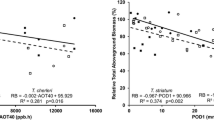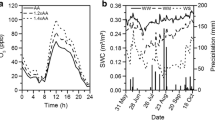Abstract
We developed small and mobile open top chambers (mini-OTC) measuring 0.6 m (W) × 0.6 m (D) × 1.2 m (H) with an air duct of 0.6 m (W) × 0.23 m (D) × 1.2 m (H). The air duct can be filled with activated charcoal to blow charcoal filtered air (CF) into the chamber, as opposed to non-filtered ambient air (NF). Ozone sensitive radish Raphanus sativus cv. Red Chime and rosette pakchoi Brassica campestris var. rosularis cv. ATU171 were exposed to NF and CF in mini-OTCs at different locations in East Asia. A total of 29 exposure experiments were conducted at nine locations, Shanghai, China, Ha Noi, Vietnam, Lampang, Phitsanulok and Pathumtani, Thailand, and Hiratsuka, Kisai, Abiko and Akagi, Japan. Although no significant relationships between the mean concentrations of ambient O3 during the experimental period and the growth responses were observed for either species, multiple linear regression analysis suggested a good relationship between the biomass responses in each species and the O3 concentration, temperature, and relative humidity. The cumulative daily mean O3 (ppb/day) could be indirectly predicted by NF/CF based on the dry weight ratio of biomass, mean air temperature, and relative air humidity.







Similar content being viewed by others
Abbreviations
- AIC:
-
Akaike information criteria
- CDMO:
-
Cumulative daily mean ozone (ppb/day)
- CF:
-
Charcoal filtered air
- DW:
-
Dry weight
- NF:
-
Non-filtered air
- O3 :
-
Ozone
- OTC:
-
Open-top chamber
- ppb:
-
Parts per billion (nL/L)
- RH:
-
Relative humidity (%)
- T:
-
Temperature in Celsius
- VPD:
-
Vapor pressure deficit (kPa)
References
Aihara, K., & Takeda, M. (2004). Development of portable open top chamber. Bulletin of Kanagawa Environmental Research Center, 27, 77–81 (in Japanese).
Akaike, H. (1974). A new look at the statistical model identification. IEEE Transactions on Automatic Control, 19(6), 716–723.
Akimoto, H. (2003). Global air quality and pollution. Science, 302, 1716–1719.
Ashmore, M., Toet, S., & Emberson, L. (2006). Ozone—a significant threat to future world food production? New Phytologist, 170, 201–204.
Ball, G. R., Benton, J., P-Brown, D., Fuhrer, J., Skarby, K., Gimeno, B. S., et al. (1998). Identifying factors which modify the effects of ambient ozone on white clover (Trifolium repens) in Europe. Environment Pollution, 103, 7–16.
Delgado-Saborit, J. M., & Esteve-Cano, V. J. (2008). Assessment of tropospheric ozone effects on citrus crops using passive samplers in western Mediterranean area. Agriculture, Ecosystems and Environment, 124, 147–153.
Emberson, L., Ashmore, M., & Murray, F. (Eds.). (2003). Air pollution impacts on crops and forests—a global assessment. In: Air pollution reviews (Vol. 4). London: Imperial College Press.
Heagle, A. S., & Stefanski, L. A. (2000). Relationships between ambient ozone regimes and white clover forage production using different ozone exposure indexes. Atmospheric Environment, 34, 735–744.
Heagle, A. S., Miller, J. E., Chevone, B. I., Dreschel, T. W., Manning, W. J., McCool, P. M., et al. (1995). Response of a white clover indicator system to tropospheric ozone at eight locations in the United States. Water, Air, and Soil Pollution, 85(3), 173–1378.
Hirano, K., Maeda, H., & Saito, K. (2002). Simultaneous determination method of NO, NO 2 , SO 2 , O 3 and NH 3 in ambient air by use of diffusional sampling devices for short-term integrated samplers (in Japanese). Kanagawa: Yokohama Environmental Science Research Institute.
Kohno, Y. (2005). Study on impacts of acidic and oxidative substances on vegetation and establishment of tentative critical level for protecting East Asian vegetation. In Summary report of research results under the GERF (pp. 279–284). Ministry of the Environment, Japan.
Mills, G., Ball, G., Hayes, F., Fuhrer, J., Skärby, L., Gimeno, B., De Temmerman, L., Heagle, A., & Members of the ICP Vegetation Programme. (2000). Development of a multi-factor model for predicting the effects of ambient ozone on the biomass of white clover. Environment Pollution, 109, 533–542.
Spranger, T., Lorenz, U., & Gregor, H-D. (2004). Manual on methodologies and criteria for modelling and mapping critical loads and levels and air pollution effects, risks and trends, Texte 52-2004, Umweltbundesamt. (UNECE/ICP Modelling and mapping manual).
Varns, J. L., Mulik, J. D., Sather, M. E., Glen, G., Smith, L., & Stallings, C. (2001). Passive ozone network of Dallas: a modeling opportunity with community involvement 1. Environmental Science and Technology, 35, 845–855.
Acknowledgments
This research was conducted with financial support from the Global Environmental Research Fund (C-7), Ministry of the Environment, Japan. We greatly appreciate the collaboration and arrangements with Dr. Tran Thi Ngoc Lan, University of Natural Sciences, Ho Chih Minh City, Vietnam, and Dr. Yasuaki Maeda, JICA Expert, Ministry of the Natural Resources and Environment, Ha Noi, Vietnam. We also appreciate Mr. Ideta, Techno Systems Co. Ltd., Tokyo, Japan for his chemical analysis of air quality samples. Additionally, we thank the students and staff of the universities and CERES Inc. at Akagi Testing Center, CRIEPI for their support with the experiments. Finally, we thank Dr. M. Frei, University of Bonn, for his critical review and editorial suggestions regarding this manuscript.
Author information
Authors and Affiliations
Corresponding author
Rights and permissions
About this article
Cite this article
Kohno, Y., Matsumura, H., Miwa, M. et al. Indirect prediction of surface ozone concentration by plant growth responses in East Asia using mini-open top chambers. Environ Monit Assess 185, 2755–2765 (2013). https://doi.org/10.1007/s10661-012-2746-2
Received:
Accepted:
Published:
Issue Date:
DOI: https://doi.org/10.1007/s10661-012-2746-2




